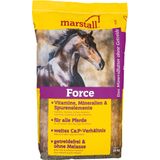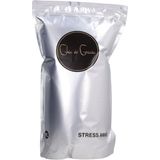Stomach Ulcers in Horses - A Disease of Civilization?
“You are what you eat.”
With regard to a healthy, nutrient-rich and calorie-adjusted diet, this applies not only to humans but also to our four-legged friends, horses. In principle, it can also be stated that high-quality feeding tailored to the special needs of horses isn't the fantasy it once was. There are myriad basic and mineral feed mixtures, grain-free or sugar-free compact mueslis and also every conceivable other form of supplementary feed and for and against every ailment, deficiency or excess. Despite this, there are various studies that show that the number of horses suffering from gastric ulcers is steadily increasing. How can that be?
How stomach ulcers arise
A stomach ulcer does not develop spontaneously. It is the result of long-term or persistent inflammatory processes in the body. Stomach acid is often responsible for this. This is permanently produced in order to correspond to the natural behaviour of the horse. This natural behaviour actually consists of eating high-fibre roughage for the majority of the day. Too much stomach acid is then normally neutralised by the saliva, which contains bicarbonate, meaning the stomach acid cannot cause any damage. If there are long breaks from eating (longer than four to six hours), there is a gastric acid-saliva imbalance. The excess gastric acid attacks the mucous membranes, causing inflammation foci, which then lead to gastric ulcers over a long period of time if the causes of permanent hyperacidity are not eliminated.
About the ratio of concentrate to roughage
Another important factor is the concentrate-to-roughage ratio. A horse chews the same amount of hay as oats with around five times as much saliva. In addition, horses eat concentrated feed much faster, which in turn leads to less saliva production. Large portions of concentrated feed then end up in the stomach, but far too little saliva, which could neutralise the gastric acid.
In the case of crib feed, it is important to divide it up into several rations a day - especially if the horse, because it is a sport or high-performance horse, receives large amounts of grain and concentrated feed.
Feed quality
Of course, the quality of the food also plays a role in the development of gastric ulcers. Food that is contaminated with pesticides, mouldy or that has fermented causes additional stress in the stomach and contributes to acidification with an increasing pH value.
In addition, silage, which shouldn't belong in the stable anyway, also has a high histamine load that does not affect the horse's sensitive stomach.
It is therefore extremely important that horses have access to high quality, dust-free and less polluted hay or top-produced haylage. Because even unlimited hay feeding - at constant free disposal - only makes sense if the quality is right. Otherwise, it will contribute to the development of gastric ulcers.
Changes in behaviour are not always meaningful
Horses with stomach problems are rarely recognisable at first glance. This is because each horse has a different response to pain. The eating behaviour usually offers the best clues: Horses that go to their crib with a good appetite, but stop eating there after a short time and turn away, could suffer from gastric ulcers. Particular aggression while eating can also be a sign of stomach pain. Incidentally, horses do not always lose weight, but over time the usability of the feed decreases and there is a lack of minerals and micronutrients.
Other factors
Today it is assumed that it's not only the stomach and diet that influence the development of gastric ulcers, especially when feeding errors and poor quality feed can be ruled out. Another starting point is peripheral pain as a basic trigger for problems in the stomach. This can have a variety of causes. It can include blockages or muscle tension, unsuitable equipment, permanent incorrect loading of the hooves or toothache - but also stress. Because stress is diverse and individually different, it is also difficult to get a grip on. As a horse owner, however, you have no choice. You have to find the stressors for your own horse and eliminate them if these are the trigger of stomach problems.
CharLine feed charcoal can be used to support stomach ulcers in a variety of ways. In this way, it can also contribute to the elimination of pollutants that burden the digestive system, as well as after drug treatment. Because the feed charcoal is odourless and tasteless and is pressed without synthetic additives, it can be a real treat for a sensitive horse's stomach! This is also regularly confirmed by feedback from satisfied CharLine customers in high-performance sports. It is precisely here that the long-term feeding of CharLine feed charcoal has confirmed various positive influences on the gastrointestinal tract of the sport horses.
Here you can find the CharLine products that we have in our shop.
Latest reviews
-
 4.8 (17)
4.8 (17)Marstall Force, 20 kg
- Minerals, trace elements, vitamins
- A high Ca:P proportion
- For all horses
€ 66,99 (€ 3,35 / kg)Delivery by January 16
-
 € 12,92 € 13,69 (€ 64,60 / l)
€ 12,92 € 13,69 (€ 64,60 / l)Delivery by January 03
-
 5.0 (2)
5.0 (2)Chia de Gracia Stress Away, 1,50 kg
- Natural blend of herbs
- Contains lavender
- With bee pollen
€ 49,49 (€ 32,99 / kg)Delivery by January 03
-
 € 31,99 (€ 1,60 / kg)
€ 31,99 (€ 1,60 / kg)Delivery by January 03
